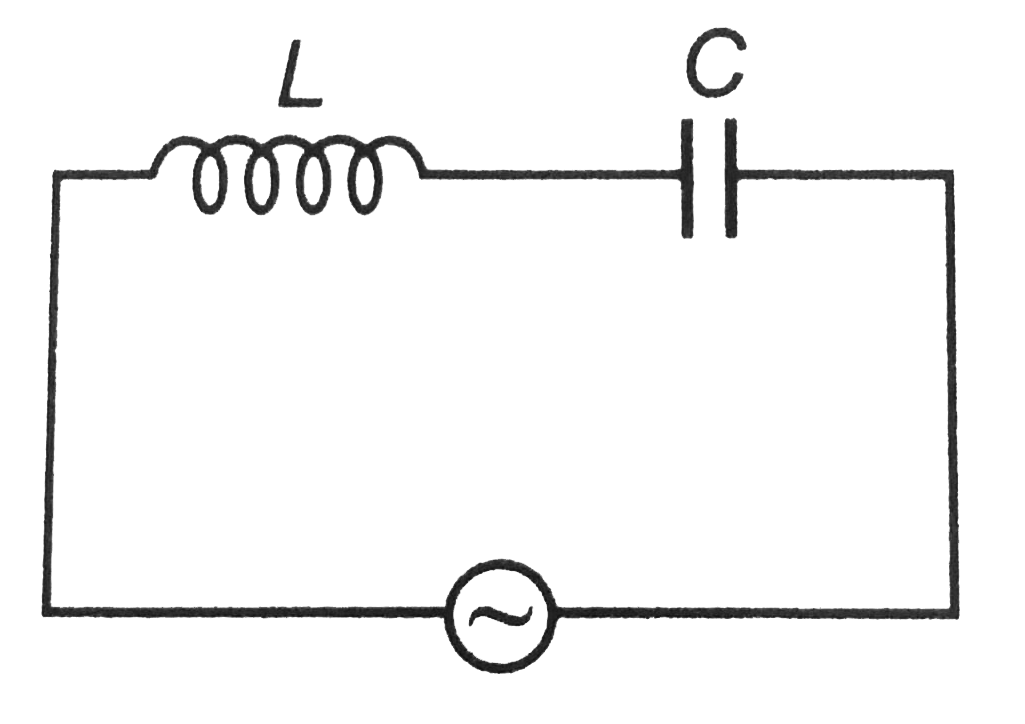A series LCR circuit is connected to an a.c. source 200 V, 50 Hz. The voltages acorss the resistor, indcutor and capacitor are respectively 200 V, 250 V and 250 V. (i) The algerbriac sum of the three voltages is greater than the source voltage. How is the paradox resolved ?
(ii) If R=40Ω, calculate the current in the circuit.
Here, Ev=2000V,v=50Hz
VR=200V,VL=250VC=250V
Now VR+VL+VC=200+250+250=700V
This is greater than source voltage 200 V. It is because, VL and VC are 180∘ out or phase and both are 90∘ out of phase with VR
∴V=√V2R+(VL−V2C)
=√2002+(250−250)2
=200V, the source voltage.
The paradox is resolved.
Current in the circuit,
Iv=EvZ=EvR=20040=5A
Topper's Solved these Questions
- BOOK - PRADEEPCHAPTER - ELECTROMAGNETIC INDUCTION & ALTERNATING CURRENTEXERCISE - Solved Examples (b)1videos
ELECTROMAGNETIC INDUCTION & ALTERNATING CURRENT
- BOOK - PRADEEPCHAPTER - ELECTROMAGNETIC INDUCTION & ALTERNATING CURRENTEXERCISE - Short Answer Qusetions2videos
ELECTROMAGNETIC INDUCTION & ALTERNATING CURRENT
- BOOK - PRADEEPCHAPTER - DUAL NATURE OF RADIATION AND MATTEREXERCISE - Exercise191videos
DUAL NATURE OF RADIATION AND MATTER
- BOOK - PRADEEPCHAPTER - ELECTROMAGNETIC WAVESEXERCISE - II Focus multiple choice question5videos
ELECTROMAGNETIC WAVES
Similar Questions
In a series RC circuit connected across an AC source of 220 V 50 Hz calculate the rms voltage across resistor and capacitor if values of R and C are 100 Ω and 20μF respectively .
View SolutionA series LCR circuit is connected top an AC power source of 220 V , 50 Hz. The values of L and R are 0.41 H and 80Ω respectively. What is the value of C if current and voltage are in phase ?
View Solution
Knowledge Check
- Question 1 - Select One
An LCR series circuit is connected to an oscillator (AC supply) having RMS voltage 200 V. If the RMS voltages across resistor, inductor and capacitor are equal, then RMS voltage across the resistor would be
A100VB200V√2C200VD100V√2 - Question 2 - Select One
In a series LCR circuit the rms voltage across the inductance , capacitance and resistance are respectively 4 V, 8 V and 5 V . The RMS voltage of the AC source in the circuit is
A17 VB13 VC5 VD6.4 V - Question 3 - Select One
A resistance of 200Ω and capacitor of 15μF are connected in series to a 220 V, 50 Hz AC source. The voltage (rms) across the resistor and capacitor is that
A151 V, 160.4 VB150 V, 100.3 VC220 V, 91.8 VD145 V, 311.3 V
A series LCR circuit is connected to an a.c. source of 220 V - 50 hz. If the readings of voltmeters acorss resistor, capacitor and inductor are 65 V, 415 V and 204 volt respectively , and R=100Ω calculate (i) current in the circuit (ii) value of L (iii) valueo of C and (iv) capacitance required to produce resonance with the given inductor L.
View SolutionIn a series RC circuit, R = 30 ohm, C=0.25μF, V=100V,ω=10000rad/s. Find the current in the circuit and calculate the voltage across the resistor and capacitor. Is the algebraic sum of these voltages more than the source voltage ? If yes, resolve the paradox.
View SolutionIn a series LCR circuit, the voltage across an inductor, a capacitor and a resistor are 20 V, 20 V and 40 V, respectively. What is the phase difference between the applied voltage and the current in the circuit ?
View SolutionIn a series L−C circuit, the applied voltage is V0. if omega is very low, then the voltage drop across the inductor VL and capacitor VC are
 .View Solution
.View SolutionIn a series LCR circuit the voltage across an inductor, capacitor and resistor are 20 V, 20 V and 40 V respectively. The phase difference between the applied voltage and the current in the circuit is
View Solution
